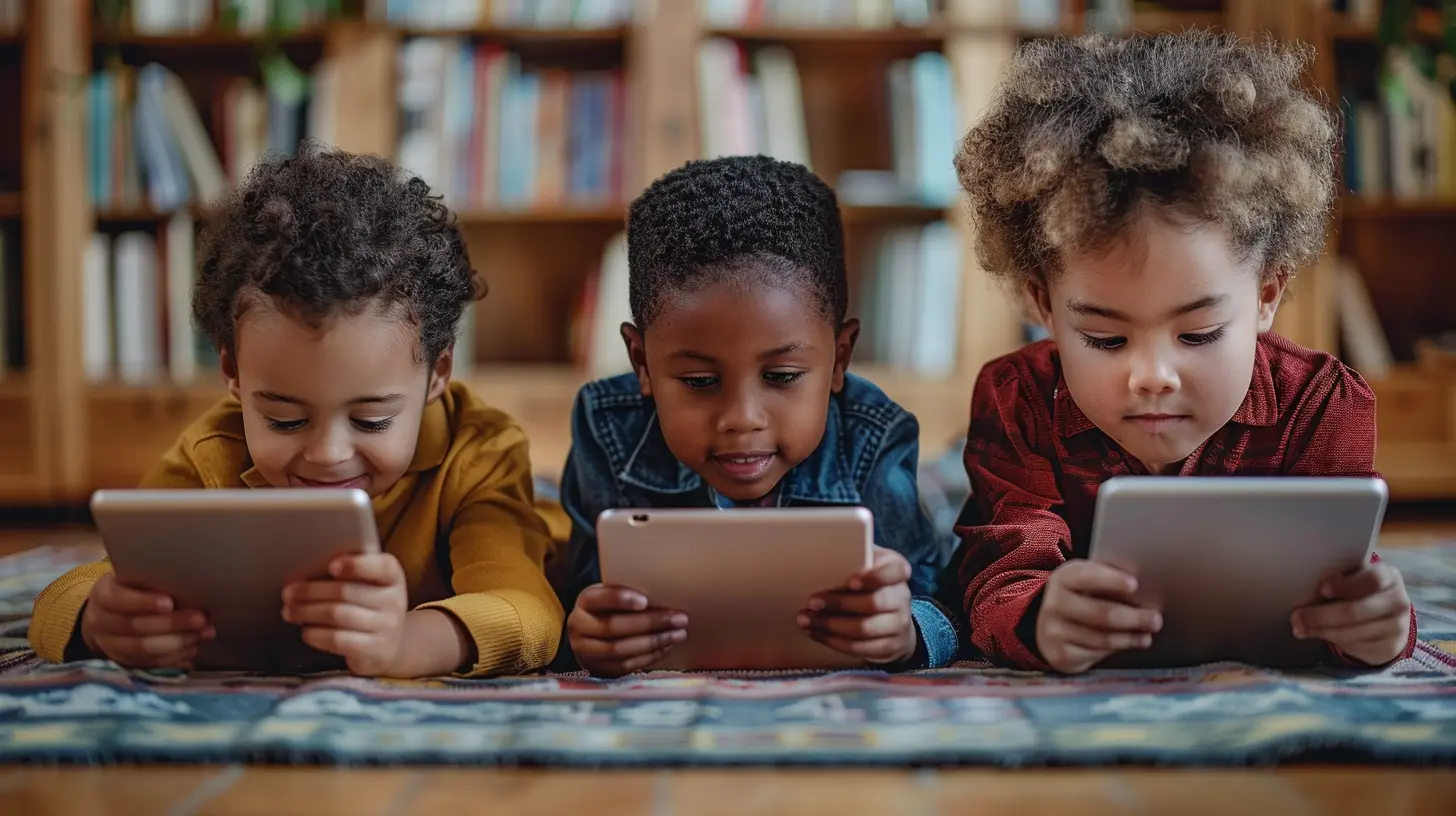Homeschooling with Technology: How to Use It Wisely
1 December 2024
Homeschooling has seen a massive rise in popularity over the past few years, and technology has played a crucial role in making it more accessible and effective. It’s no secret that the internet offers a seemingly endless trove of learning resources and tools. But, as homeschooling parents, how can we ensure we’re using technology wisely? Like any tool, it can either enhance your homeschooling experience or turn into a distraction.
I’m sure you’ve been there: one minute, your child is watching an educational video, and the next, they’re lost in the labyrinth of unrelated YouTube videos. It’s a fine line to walk, but with the right mindset and strategies, technology can become your homeschooling MVP (Most Valuable Player). Let’s dive into how to harness the power of tech, while keeping its potential pitfalls at bay.

Why Use Technology in Homeschooling?
Before we move on to best practices, it’s important to understand why technology is such a game-changer in homeschooling.Endless Resources at Your Fingertips
When it comes to homeschooling, technology opens up a world of possibilities. Gone are the days when you had to rely solely on textbooks (and let’s be honest, textbooks can get pretty dry). With a few clicks, you have access to virtual libraries, interactive apps, online courses, videos, and even VR experiences. The variety of materials ensures that you can find something to match your child’s learning style—be it visual, auditory, or kinesthetic.Flexibility and Customization
One of the biggest benefits of homeschooling is the ability to tailor education to fit your child’s needs. Technology takes that personalization and puts it on steroids. Whether your child is a math whiz who needs extra challenges or someone who needs extra time to grasp certain concepts, online resources allow them to learn at their own pace.You can easily switch between subjects, adjust the difficulty level of lessons, or dig deep into a topic they’re passionate about—all within the confines of your own home. It's like having an infinite library right at your fingertips.
Preparing Kids for the Future
Let’s face it, technology isn’t going anywhere. In fact—love it or hate it—it’s the future. By incorporating digital tools into homeschooling, you’re not just teaching subjects like math and history; you’re also helping your child develop critical 21st-century skills such as digital literacy, critical thinking, and problem-solving.That said, not all tech is created equal, and it's important to be intentional about how you use it.

Incorporating Technology: Finding the Balance
Just because you can use technology doesn’t mean you should use it all the time. Finding a balance between screen time and other learning methods is important for your child’s well-being.Set Rules for Screen Time
Like I said, it’s easy for a child (or even an adult, let’s be real) to get sidetracked by technology. Suddenly, productive learning time can transform into hours of mindless browsing. To avoid this, consider setting some ground rules for screen time. This doesn’t need to be a prison sentence—just clear, structured guidelines.For example, you could designate specific times of the day for using the tablet or computer for school tasks and limit recreational screen time. Another good strategy is the “screen-time sandwich”: start the learning day with offline activities such as reading, then transition to online tasks, and end the day with non-tech activities like art, crafts, or physical exercise.
Tip: Use apps or device settings to implement time limits automatically. Apps like Freedom or Google’s Family Link can make managing screen time easier.
Mix It Up
Make sure technology doesn’t dominate your homeschooling day. Mix digital learning with hands-on activities. For instance, if your child is learning about ancient Egypt, they can watch a video on pyramids (technology) but follow it up with a DIY project to build their own mini pyramid using Lego bricks or clay (hands-on).This not only reduces monotony for your child but also reinforces learning in multiple ways. Remember, the brain retains information better when it receives it through different methods.
Keep an Eye on Content
Kids are naturally curious. Once they have a device in front of them, they’ll inevitably want to explore. As much as we want to encourage curiosity, the internet can be a double-edged sword. You don’t want your child wandering into corners of the web you didn’t plan for.Make sure the apps, websites, and platforms your child is using are appropriate and education-focused. Use parental controls to lock certain apps or websites if necessary, and have regular discussions with your child about safe and responsible internet use.

Must-Have Tools for Homeschooling with Technology
So, what are the best tools to have in your homeschooling toolkit? Here are some that can enhance your child’s learning experience without overwhelming them (or you).Educational Apps
There’s an app for literally everything—from math drills to learning to play the piano. And the best part is that many of these apps turn learning into a game, making education fun and interactive.- Khan Academy: A classic go-to for subjects like math, science, and history. Their videos aren’t just informative—they’re easy to follow and engaging.
- Duolingo: Teaching a foreign language? This app turns language learning into a game, making it perfect for kids who might otherwise find language lessons repetitive.
- Scratch: For kids interested in coding, Scratch is a beginner-friendly platform that teaches the basics of programming through interactive play.
E-Books & Audiobooks
Not every child is a fan of reading physical books, but digital books and audiobooks can often bridge the gap. Using tools like Kindle or Audible allows you to bring stories to life in a different medium. Plus, you can keep an entire library on one device, which is a huge space-saver in any homeschool setup.Virtual Tours & Field Trips
You may not always have the opportunity to take a physical field trip, but virtual tours are the next best thing. Museums, zoos, and even space stations offer virtual tours that allow your child to explore new places from the comfort of home.- Google Arts & Culture: This offers virtual access to some of the most famous museums around the world, including the British Museum and the Louvre.
- Smithsonian National Museum of Natural History: Take a 360-degree tour through its exhibits right from your living room.
Learning Management Systems (LMS)
An LMS can help you organize academic content, track progress, and keep assignments in one place. There are free options like Google Classroom or paid versions like Seesaw and Canvas. These tools provide a structure that can help both parents and kids stay on top of homeschooling lessons.
Avoiding the “Tech Trap”
Technology is fantastic—until it isn’t. So how do you avoid falling prey to the tech trap, where devices become more of a hindrance than a help?Avoid Over-reliance
It’s tempting to let technology do all the heavy lifting, especially when certain apps and platforms offer attractive, all-in-one solutions. However, relying too heavily on tech can have its downsides. Just because your child is watching an educational video doesn’t mean they're fully absorbing the information, especially if they're passively watching.Balance tech-based lessons with active discussions, worksheets, or even storytelling. Go beyond the screen by engaging in conversations about what your child has learned and applying those lessons to real-world examples.
Encourage Problem-Solving Without Google
We all love Google, but there’s something to be said for allowing your child to struggle a little and figure things out without immediately turning to a search engine. Encourage your child to think critically, reason through a problem, or look for solutions in books, nature, or hands-on experimentation before relying on tech for the answer.This kind of critical thinking can sometimes feel slower, but it builds cognitive skills and problem-solving abilities that they will need in life.
Practice Digital Detox
Because homeschooling already involves a lot of screen time, practicing “digital detoxes” is essential to avoiding burnout and screen fatigue. Incorporate screen-free days or hours where you and your child step away from the devices and engage in outdoor activities, exercise, or creative play.Wrapping Up: Tech Is a Tool, Not a Teacher
At the end of the day, technology should be a tool in your homeschooling toolbox, not the teacher itself. It can open doors and provide incredible learning opportunities, but it should never replace real-world experiences, hands-on activities, and, most importantly, your involvement in the learning process.You’ll need to find what works best for you and your child, and that might mean some trial and error. Use technology wisely, and it can be a fantastic ally in your homeschooling journey—but never forget that the best lessons often happen beyond the screen.
all images in this post were generated using AI tools
Category:
HomeschoolingAuthor:

Zelda Gill
Discussion
rate this article
14 comments
Quincy Harris
Embrace technology fearlessly; it’s a powerful tool for modern homeschooling!
February 2, 2025 at 4:32 PM

Zelda Gill
Absolutely! Embracing technology can enhance the homeschooling experience and provide valuable resources for both students and parents.
Vesper Rhodes
Embracing technology in homeschooling can enhance learning experiences, but balance is crucial. Prioritize interactive tools that promote critical thinking and creativity, while setting boundaries to prevent distractions. Intentional use empowers children to thrive in a digital world.
January 29, 2025 at 4:31 PM

Zelda Gill
Thank you for your insightful comment! Balancing technology and interactive tools is essential for fostering creativity and critical thinking in homeschooling. Emphasizing intentional use will truly help children thrive.
Fletcher Jones
Embracing technology in homeschooling can be transformative, offering diverse resources and engaging experiences. However, balance is key. Prioritize meaningful interactions and hands-on learning to ensure that technology enhances your child's education rather than overshadowing essential life skills and personal connections.
January 26, 2025 at 4:57 AM

Zelda Gill
Thank you for your insightful comment! Balancing technology with meaningful interactions is crucial in homeschooling. Prioritizing hands-on experiences ensures that we enhance education while fostering essential life skills and connections.
Niva Bowman
This article offers valuable insights into effectively integrating technology into homeschooling. It highlights the balance between educational tools and personal interaction, ensuring children benefit from both. Emphasizing responsible usage can nurture independent learning while fostering creativity, making it a beneficial read for homeschooling parents.
January 22, 2025 at 4:57 AM

Zelda Gill
Thank you for your thoughtful feedback! I'm glad you found the article helpful in balancing technology and personal interaction in homeschooling. Your insights on responsible usage and fostering independent learning are much appreciated!
Lauren Ortiz
Ah, the joys of homeschooling with technology! It’s like being a wizard—just with less magic and more Wi-Fi passwords. Remember, balance is key: screen time for education, and snack breaks for maintaining sanity. Happy homeschooling!
January 19, 2025 at 5:47 AM

Zelda Gill
Thank you! Balancing tech use with breaks is essential for successful homeschooling. Happy learning!
Halle Marks
Empower learning through balance!
January 13, 2025 at 5:58 PM

Zelda Gill
Thank you! Striking a balance is key to maximizing the benefits of technology in homeschooling.
Romina Diaz
Thank you for this insightful article! As a homeschooling parent, I appreciate your balanced approach to integrating technology. It’s a reminder that while tech can enhance learning, our focus should always be on creating meaningful connections and experiences for our children. Truly inspiring!
January 8, 2025 at 5:36 AM

Zelda Gill
Thank you for your thoughtful comment! I'm glad you found the article helpful and inspiring. Balancing technology with meaningful experiences is key to enriching our children's education.
Lexi Matthews
Great insights! Embracing technology in homeschooling can truly enhance learning experiences when used thoughtfully. Thank you for sharing these valuable tips!
January 4, 2025 at 3:55 PM

Zelda Gill
Thank you for your thoughtful feedback! I'm glad you found the tips valuable. Embracing technology mindfully can really transform homeschooling experiences.
Caleb McIntosh
Homeschooling with tech? Just remember: Google is your best friend, but Netflix is the slippery slope. One minute you’re teaching math, the next you’re deep in cat videos!
January 2, 2025 at 4:31 AM

Zelda Gill
Thanks for highlighting that balance! Using tech mindfully can enhance learning while keeping distractions at bay.
Everett Coleman
This article offers valuable insights on integrating technology into homeschooling. It highlights the importance of balance, ensuring that tech enhances learning without replacing hands-on experiences and meaningful interactions essential for children's development.
December 23, 2024 at 4:51 AM

Zelda Gill
Thank you for your thoughtful comment! I'm glad you found the article valuable in emphasizing the balance between technology and hands-on experiences in homeschooling.
Francesca Ramirez
Great insights! Balancing technology in homeschooling is crucial. It's easy to get overwhelmed by options, but using tools intentionally can enhance learning without dominating it. Remember to encourage offline activities too, ensuring a well-rounded education that fosters creativity and critical thinking alongside digital skills.
December 15, 2024 at 3:22 PM

Zelda Gill
Thank you for your thoughtful comment! Striking that balance is key to effective homeschooling. Encouraging both digital and offline activities truly enriches the learning experience.
Finnian McInnes
Utilizing technology in homeschooling can enhance learning, but balance is key. Prioritize interactive, creative tools over passive consumption to foster critical thinking and engagement.
December 6, 2024 at 5:47 PM

Zelda Gill
Absolutely! Striking the right balance between technology and interactive learning is essential for fostering engagement and critical thinking in homeschooling.
Bryson McLemore
Great tips! Technology truly enhances our homeschooling experience.
December 2, 2024 at 5:20 AM

Zelda Gill
Thank you! I'm glad you found the tips helpful. Embracing technology can really transform the homeschooling journey!
Knox Hines
Thank you for this insightful article! It’s reassuring to see practical tips for using technology wisely in homeschooling. I appreciate the guidance for fostering balanced learning environments.
December 1, 2024 at 3:24 AM

Zelda Gill
Thank you for your kind words! I'm glad you found the tips helpful for creating a balanced learning environment. Happy homeschooling!
MORE POSTS

Teaching Problem-Solving Skills Using Positive Reinforcement

Talking About Drugs and Alcohol with Your Teen

How to Navigate Difficult Conversations with Teachers About Bullying

Starting Your Homeschool Day with Intention

Essential Tips for Soothing Your Newborn at Night

Effective Communication Strategies with Your Teenager

The Joy of Kite-Flying: A Timeless Outdoor Activity

How to Plan Your Homeschool Year with Intention

Building Confidence with Outdoor Obstacle Courses